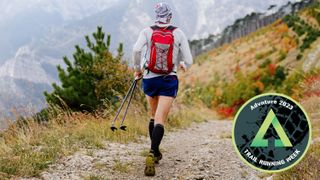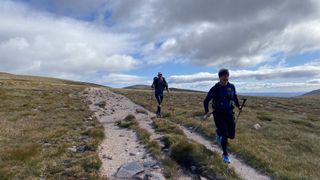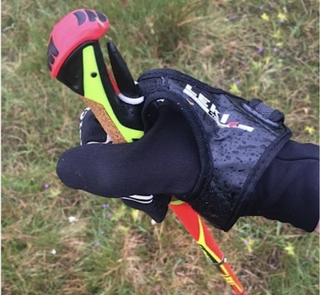Trail running with poles – how they can help you go faster for longer
A guide to the benefits of trail running with poles – and how to use them for best effect

While the best trekking poles are a common sight among hikers, they are now increasingly utilised by trail runners, too. They are said to be one of the best things to take trail running.
Running poles are usually lighter in weight than walking poles and are frequently made of carbon products. If poles are lightweight they will help you to run without feeling hampered.
Poles utilised by trail runners will usually fold into a smaller bundle for easier stowing in a running pack when not in use and they usually have a useful hand-holding system to allow for a more fluid motion when on the trails. Many trail running poles also have adjusters so that you can use them on different gradients.
Reasons for trail running with poles include efficiency, especially on hills. Being able to use both your legs and arms to help get you up steep gradients gives an extra boost to speed and power. Poles are also aid to save energy for runners, so this means you can keep going for longer.
When running downhill or on uneven terrain, trail running with poles can help with balance and to minimise the impact on legs and knees.

When and how to use poles for trail running
Trail running with poles is a good idea if you're planning on covering large distances, if the terrain is likely to be very rough and uneven and/or if the gradients are steep.
The best trail running poles are those that have a hand strap. With a basic strap, make sure your hand goes through the strap from bottom to top, then lightly hold the handle. This will allow you to push down hard on the straps while, at the same time, your hand can remain relaxed.
Advnture Newsletter
All the latest inspiration, tips and guides to help you plan your next Advnture!
Some poles have a glove-like strap system. The open glove is worn on the hand with thumb and fingers free. This glove is then attached to the pole by a clip, which gives good freedom of movement. Again, this allows the hand to remain relaxed while you push off on the pole.
To use the poles to best effect, you need to learn to synchronise. To practise this, walk without using your poles and with your arms at your sides. Then start to swing your arms naturally by you sides. Now, start to introduce the poles while using the same natural swing.
What should happen is that as your legs move, you opposite hand and arm will come up. If you think about trail running with poles too much as you do it, you will end up feeling awkward and out of sync. The best tip is to walk naturally and then build up to a run, swinging the poles as an extension of your arms.

How to use poles for trail running
The type of terrain will dictate how you use the poles. If you are running or walking uphill on a gentler slope, you’ll use your poles naturally as if running with your arms at your sides.
The aim is to alternate the arms naturally and to plant the pole next to each foot. Try to angle the poles so they hit the ground slightly to your rear because this allows you to push forward as you take the next running step.
If you are running faster, you might want to plant the poles every two or three steps to avoid the possibility of slowing yourself down or reducing your running flow.
At steep slopes, you may want to switch to a double pole plant technique. The method is to plant the poles together in line and ahead of you up the slope. You can then lean forward on to the poles and drive yourself forwards and uphill.
If running or walking on a contour, you can shorten the pole that is uphill of you, of hold the pole further down the shaft (some poles have an extra long hand-hold for this option) so that the pair of pole tops remain at the same height.
When running downhill, you can use the poles as an aid to stop you becoming unbalanced on rough terrain. You can plant the poles where needed on ground that is rock strewn or boggy. Using the poles downhill will also reduce the impact of the inevitable pounding.

How to carry trail running poles
If you do not want to use your poles for a short time while running, simply hold them in your hands horizontally and off the ground. Balance the poles evenly by holding them loosely in the middle of the stem.
If you know you will not need the poles for a longer period, you can fold them up – hopefully they fold into three parts for easier stowing – and attach them to fixing points on your favourite running pack. Most running packs have a place to fix poles when not in use.
In conclusion, whether you are getting started with trail running or an experienced trail runner, trail running with poles can be very helpful indeed.

This article is part of Advnture's Trail Running Week 2023 (running from Monday 27 March to Sunday 2 April), our in-depth look at how to train smarter, choose the right gear, and have fun when things get muddy.

Fiona Russell is a widely published adventure journalist and blogger, better known as Fiona Outdoors. She is based in Scotland and is an all-round outdoors enthusiast with favorite activities including trail running, mountain walking, mountain biking, road cycling, triathlon and skiing (both downhill and backcountry). Aside from her own adventures, Fiona's biggest aim is to inspire others to enjoy getting outside and exploring, especially through her writing. She is also rarely seen without a running skort! Find out more at Fiona Outdoors.
Most Popular

